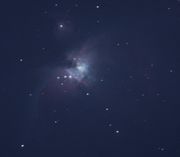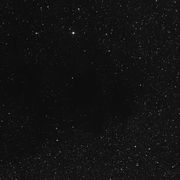Nebula
m |
|||
| Line 1: | Line 1: | ||
[[image:M42.jpg |thumb|M42]] | [[image:M42.jpg |thumb|M42]] | ||
| − | It is common to believe that the vastness of space between stars is empty. There are, however large clouds of dust and gas drifting amongst the stars. These clouds are called nebulae (singular nebula). Originally, most deep sky objects were called nebulae since most deep sky objects look like fuzzy clouds through the telescopes of the 19th century so, for example, for a long time [[galaxy|galaxies]] were also called nebulae. Nowadays the term nebulae is reserved for clouds of gas or dust or for [[planetary nebula|planetary nebulae]], [[supernova remnant|supernova remnants]], [[#Dark Nebulae|dark nebulae]], [[#Emission Nebulae|emission nebulae]], and [[#Reflection Nebulae|reflection nebulae]]. This article will look at dark, emission and reflection nebulae. | + | It is common to believe that the vastness of space between stars is empty. There are, however large clouds of dust and gas drifting amongst the stars. These clouds are called nebulae (singular nebula). Originally, most deep sky objects were called nebulae since most deep sky objects look like fuzzy clouds through the [[telescope|telescopes]] of the 19th century so, for example, for a long time [[galaxy|galaxies]] were also called nebulae. Nowadays the term nebulae is reserved for clouds of gas or dust or for [[planetary nebula|planetary nebulae]], [[supernova remnant|supernova remnants]], [[#Dark Nebulae|dark nebulae]], [[#Emission Nebulae|emission nebulae]], and [[#Reflection Nebulae|reflection nebulae]]. This article will look at dark, emission and reflection nebulae. |
==Dark Nebulae== | ==Dark Nebulae== | ||
Latest revision as of 19:35, 18 November 2009
It is common to believe that the vastness of space between stars is empty. There are, however large clouds of dust and gas drifting amongst the stars. These clouds are called nebulae (singular nebula). Originally, most deep sky objects were called nebulae since most deep sky objects look like fuzzy clouds through the telescopes of the 19th century so, for example, for a long time galaxies were also called nebulae. Nowadays the term nebulae is reserved for clouds of gas or dust or for planetary nebulae, supernova remnants, dark nebulae, emission nebulae, and reflection nebulae. This article will look at dark, emission and reflection nebulae.
Contents |
[edit] Dark Nebulae
Many nebulae are vast clouds of dust and gas. These nebulae are cold and hence don't glow on their own making them next to invisible and hence, dark. Since they don't emit their own light, they can't be seen directly. Despite this, several dark nebulae are visible to the naked eye. How is this? Dark nebulae block the light of stars or other objects behind them. This causes "holes" in the Milky Way such as the Coal Sack. Of course for this to work you have to be somewhere dark enough to to see the Milky Way. The Horsehead Nebula is also a dark nebula, blocking out the bright nebula behind it.
Interstellar dust can also be detected through interstellar extinction and through interstellar reddening. Interstellar extinction is caused when the dust only partially obscures the objects behind it, This causes the objects behind the dark nebula (usually a star) to appear dimer than would be expected from the background object's distance and intrinsic brightness.
Interstellar reddening is also caused by clouds of interstellar dust and gas. The dust and gas of the nebula tend to block the shorter wavelengths of light (blue) while allowing most of the longer wavelengths of light (red) through. This makes objects behind the nebula appear redder than they actually are[1].
[edit] Reflection Nebulae
Some cold nebulae are visible not due to the light they create, but due to reflecting the light of a nearby star or stars. These nebulae tend to be bluish in colour, as they tend to be more efficient at reflecting/scattering shorter wavelengths of light, similar to why the daytime sky on Earth is blue[1]
[edit] Emission Nebulae
Emission nebula are visible by their own light. Generally, an emission nebula is made up mostly of gas. This gas is excited by ultraviolet light from nearby stars. This causes the electrons in the atoms that make up the gas to jump to higher orbits. When they return to a lower orbit, they emit a photon of light. This makes emission nebulae analogous to neon lights here on Earth, though the gas in an emission nebula is mostly hydrogen[1].
[edit] Nebular formation
Part of the gas and dust floating around may simply be left over from the formation of the universe as not all the matter floating around at the time would have condensed into stars. However most of this would likely be hydrogen and perhaps some helium. This means that a large part of the gas and dust will have come from stars. Stars return gas and dust into space partially through their stellar winds but mostly in their death throes. Small mass stars such as the Sun throw much of their mass off forming planetary nebulae. Larger stars explode in supernova explosions forming supernova remnants. This throws much gas and dust into interstellar space. Much of this gas finds it's way into nebulae which in turn begin to condense and form new stars[2]. M42 is such a nebula where stars are being formed.

